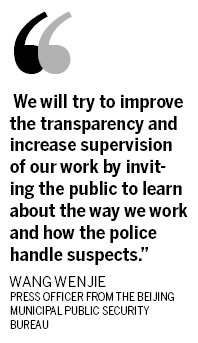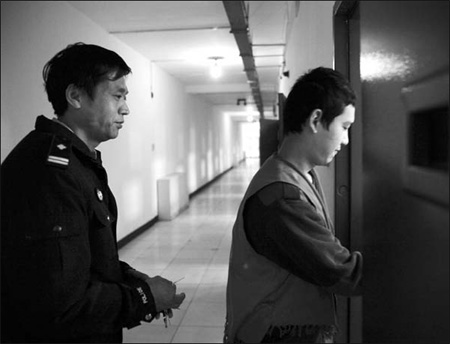Focus
Detention centers aim for transparency
By Zhang Yan (China Daily)
Updated: 2010-03-22 07:55
 |
Large Medium Small |
|
Members of the public and social organizations visiting detention center will not be allowed to see cells actually holding detainees. Wang Jing / China Daily |
But relatives of detainees still face significant visitation restrictions
All of Beijing's 22 city and district-level detention centers will be open to the public and social organizations before June in a bid to eliminate public suspicion about prison guards abusing detained suspects, the Beijing Municipal Public Security Bureau said last Tuesday.
Eight of the capital's detention centers were opened last November.
"We will try to improve the transparency and increase supervision of our work by inviting the public to learn about the way we work and how the police handle suspects," said Wang Wenjie, press officer from the Beijing Municipal Public Security Bureau. "This may help allay people's suspicion about the way we treat detainees and protect our image of respecting human rights."
But restrictions remain for those who choose to visit the detention centers.

Members of the public and social organizations wishing to visit the centers must make a formal request, fill in an application form including an introduction letter from their employers and valid identification and then wait for approval from the relevant detention center's management department, according to Wang.
Once permission is granted applicants must visit the center within 15 days. As many as 20 people can visit the detention center as a group, he said.
Visitors will be allowed into the detention houses' reception rooms, libraries, lecture rooms, dining halls, medical clinics and into vacant cells but not into cells that actually hold suspects.
Direct relatives of detained suspects will only be allowed to visit after the suspect has gone on trial and a verdict has been reached, said Wang.
Suspects who are found guilty will be held in the detention center for 10 days after the trial, during which they can appeal the verdict. It is during this 10-day window that relatives can visit the detention house.
But even then only three relatives can visit at one time, said Wang.
Beijing has made efforts to make its detention system more transparent after the death of an inmate in Yunnan province last year during what local prison authorities there said was a rough game of "hide and seek". Local Yunnan prosecutors allege the case was the result of the police officers' lax management.
| ||||
If any alleged incidents of detainee abuse happen in the detention house during the 15 days, the relevant records can immediately be used for an investigation.
"With the help of the monitoring system, we can detect what's happening in any place at any moment in the detention house. This greatly reduces the chances of violent abuse of the detainees," said Gao.
|
A detainee is escorted to his cell by a guard. Wang Jing / China Daily |
The maintenance fee of the monitoring equipment is as much as 400,000 yuan per year, Gao said.
The system already stopped one potential incident, last November, when two detainees began to fight, egged on by other detainees. Guards were notified by surveillance staff and quickly rushed to the scene to stop the fight from escalating.
There are 800 detained suspects in the Changping District Detention Center, including 700 males, 100 females and 10 minors, most of them detained on charges of robbery, theft, fighting in public or organized prostitution.
The whole detention house is divided into six supervision blocks and the 100 female detainees are put separately in the No.6 supervision area. Each supervision area includes 11 cells and 12 to 18 detainees are usually put in the same cell, said Gao.
There are four police officers in each supervision block, which mean each officer is watching about 40 to 60 detainees.
Each cell is also equipped with alarms that detainees can press to bring help in an emergency situation.
The alarms have already proved useful at least once, according to Gao.
A detainee who suffered a stroke last April was rushed to a hospital for surgery after fellow detainees sounded the alarm.
There are also three inspection personnel from the Beijing People's Procuratorate monitoring the Changping District Detention Center.










